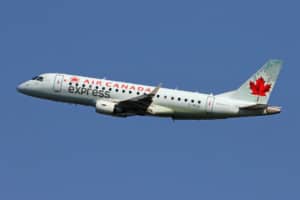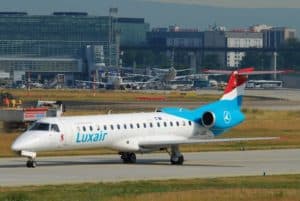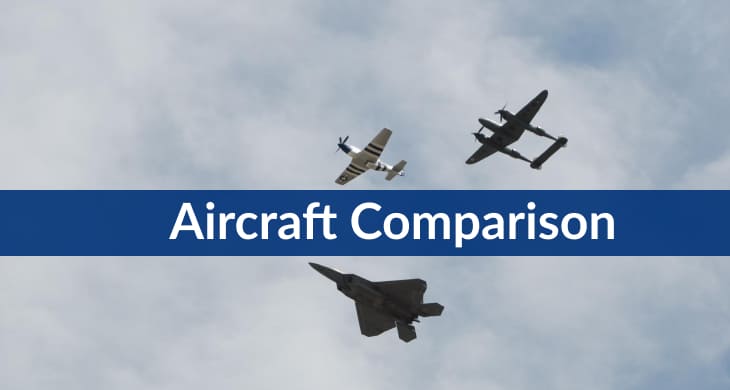While they share many similarities, some key differences set them apart. This blog post will take a closer look at ERJ 175 vs ERJ 145, highlighting their features and capabilities.
| Aircraft: | Embraer 175 | Embraer ERJ 145 |
|---|---|---|
| Photo: |
 |
 |
| Country: | Brazil | Brazil |
| Manufactured: | from: 2004 to: Present | from: 1989 to: Present |
| ICAO: | E175 | E145 |
| Price: | $45.7 million | $21 million |
| Avionics: | Honeywell Primus Epic | Honeywell Primus 1000 |
| Engine: | 2x 2 X General Electrics CF34-8E | 2x 2 X Rolls-Royce AE3007 A |
| Engine Type: | Turbofan | Turbofan |
| Power: | 14,200 pound-force | 8,169 pound-force |
| Max Cruise Speed: |
480 knots 889 Km/h |
453 knots 839 Km/h |
| Approach Speed (Vref): | - | 135 knots |
| Travel Range: |
2,200 Nautical Miles
4,074 Kilometers |
1,550 Nautical Miles
2,871 Kilometers |
| Fuel Economy: |
0.65 nautical mile / gallon 0.318 kilometres / litre |
0.92 nautical mile / gallon 0.450 kilometres / litre |
| Service Ceiling: | 41,000 feet | 37,000 feet |
| Rate of Climb: |
2000 feet / minute 10.16metre / second |
2000 feet / minute 10.16metre / second |
| Take Off Distance: |
2244 metre 7,362.12 feet |
2270 metre 7,447.42 feet |
| Landing Distance: |
1261 metre 4,137.09 feet |
1400 metre 4,593.12 feet |
| Max Take Off Weight: |
40,370 Kg 89,000 lbs |
22,000 Kg 48,501 lbs |
| Max Landing Weight: | - |
19,300 Kg 42,549 lbs |
| Max Payload: |
10,094 Kg 22,253 lbs |
5,786 Kg 12,756 lbs |
| Fuel Tank Capacity: |
3,072 gallon 11,629 litre |
1,690 gallon 6,397 litre |
| Baggage Volume: |
9.2 m3 325 ft3 |
9.2 m3 325 ft3 |
| Seats - Economy: | 88 seats | 50 seats |
| Seats - Business Class: | 86 seats | - |
| Seats - First Class: | - | - |
| Cabin Height: |
2 metre 6.56 feet |
1.82 metre 5.97 feet |
| Cabin Width: |
2.74 metre 8.99 feet |
2.1 metre 6.89 feet |
| Cabin Length: |
21.2 metre 69.55 feet |
16.49 metre 54.10 feet |
| Exterior Length: |
31.68 metre 103.94 feet |
29.87 metre 98.00 feet |
| Tail Height: | 9.86 metre - 32.35 feet | 6.75 metre - 22.15 feet |
| Fuselage Diameter: |
3.01 metre 9.88 feet |
2.28 metre 7.48 feet |
| Wing Span / Rotor Diameter: |
26 metre 85.30 feet |
20.04 metre 65.75 feet |
| Wing Tips: | Blended Tips | No Winglets |
| More Info: | Embraer 175 | Embraer ERJ 145 |
|
Data presented is for entertainment purposes and should not be used operationally.
|
Other Embraer 175 comparisons:
Other Embraer ERJ 145 comparisons:
About the E175
The E175 is a twin-engine, regional jet aircraft that was first introduced in 2005. The aircraft is regularly used by major airlines and is applauded for its fuel efficiency.
Thanks to its modern engines, it consumes 20% less fuel than similar aircraft. This makes the E175 a cost-effective option for airlines, and has become one of the most popular regional jets in service today.
Why was it developed and built?
The E175 was developed to meet the needs of regional airlines for aircraft. One that could carry more passengers than the standard regional jet while still providing fuel efficiency and low operating costs.
What purpose does it serve?
The E175 is a member of the Embraer E-Jet family, including the smaller E170 and the larger E190. It has a maximum capacity of 78 passengers and a range of 2,200 nautical miles.
It is powered by two General Electric CF34 engines, which provide excellent fuel economy and low noise levels. The flight deck has the latest avionics, including GPS and an enhanced vision system.
About the ERJ 145
Think of the ERJ 145 as the older brother of the E175. The ERJ 145 was introduced by Embraer in 1995 and is one of the most successful regional jet aircraft ever produced. It is also powered by two General Electric CF34 engines and has a maximum capacity of 50 passengers.
Why was it developed and built?
The ERJ 145 was designed to meet the needs of regional airlines for smaller aircraft than the larger ones typically used for long-haul flights. It has an impressive range and is very fuel efficient, making it popular with airlines looking to keep costs down. First introduced in 1996, it’s been a favorite of aviation enthusiasts ever since, thanks to its impressive performance and unique design.
What purpose did it serve?
The ERJ 145 can seat up to 50 passengers and has a range of over 2,873 miles. That makes it perfect for short-haul flights. But the ERJ 145 isn’t just a workhorse – it’s also a beauty.
The aircraft features sweeping lines and a sleek profile, making it one of the most stylish regional jets. And with its comfortable cabin and modern amenities, the ERJ 145 will make any flight enjoyable.
How are the E175 and ERJ 145 different?
The E175 and ERJ 145 are both Embraer jets but have some major differences.
Size Matters
One of the most obvious differences between the E175 and ERJ 145 is their size. The E175 is a larger aircraft, with a length of 31.67 meters (103 feet 11 inches) and a wingspan of 28.65 meters (94 feet).
The ERJ 145, on the other hand, is slightly smaller! Due to its larger size, the E175 can accommodate 110 passengers in a two-class configuration or 124 passengers in a single-class configuration.
Performance Differences
The larger size of the E175 also gives it a better performance than the ERJ 145. It has a maximum range of 3,400 kilometers (2,112 miles), compared to 3,000 kilometers (1,864 miles) for the ERJ 145.
Concerning speed, the E175 has a maximum cruise speed of 871 kilometers per hour (470 miles per hour), while the ERJ 145 has a maximum cruise speed of 808 kilometers per hour.
The E175 can reach 41,000 feet, while the ERJ 45 tops at 37,000 feet.
How are the E175 and ERJ 145 similar?
The Embraer E175 and ERJ 145 are regional jets manufactured by the Brazilian aerospace manufacturer Embraer. Here are a few similarities between the two aircraft:
- Both are turbofan-powered and have twin engines, with the E175 powered by CF34 engines and the ERJ 145 powered by PW535 engines.
- The Embraer 175 and the ERJ 145 are popular regional jets that seat about 70 passengers.
- Both aircraft are fly-by-wire, meaning electronic signals control the flight surfaces instead of cables or hydraulic systems.
- The Cockpit Voice Recorder (CVR) and Flight Data Recorder (FDR) are also located in the same place on both aircraft, making them easier to find in the event of an accident.
- The E175 and ERJ 145 are equipped with winglets, which help reduce fuel consumption by improving aerodynamic efficiency.
- Finally, both aircraft have a similar range, meaning they can travel about the same distance without stopping to refuel.
As a result, they are both well-suited for regional travel.
What’s better about the E175?
E175 is a twin-engine, single-aisle jetliner that first flew in 2005. Since then, it has become one of the most famous aircraft in its class. There are several reasons for the E175’sE175’s popularity.
- First, it is highly fueled efficient, thanks to its advanced engines and aerodynamic design.
- Second, it has a spacious, comfortable cabin with large windows and ample storage space.
- Third, it is incredibly versatile and can operate equally efficiently on short or long routes.
- Finally, it has an excellent safety record, with no hull loss accidents in over 15 years of service.
In short, the Airbus E175 is an outstanding aircraft in every respect, and it is no wonder that it is so popular with passengers and airlines alike.
What’s better about the ERJ 145?
There are several reasons why the ERJ 145 was an excellent choice for regional travel.
- First, the aircraft has a range of nearly 2873 miles, which is more than enough to cover most domestic routes.
- Second, the ERJ 145 can seat up to 50 passengers, making it ideal for small-scale flights.
- Finally, the aircraft has state-of-the-art safety features, including an advanced flight deck and cabin crew rest area.
As a result, the ERJ 145 is an excellent choice for regional travel.
Conclusion
E175 and ERJ 145 are two of the most famous aircraft in their respective classes.
- The E175 is an excellent choice for long-haul flights, thanks to its efficient engines, spacious cabin, and excellent safety record.
- The ERJ 145 is a great option for regional travel due to its long-range, generous seating capacity, and advanced safety features.
Both offer exceptional comfort levels, reliability, and performance, making them perfect for any aircraft operator.


